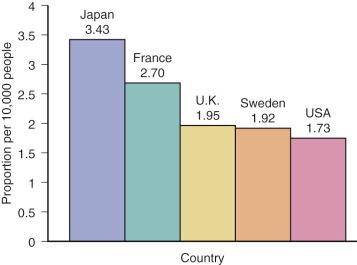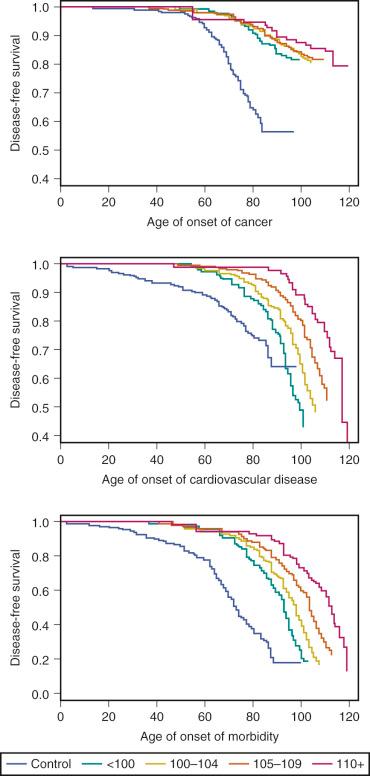Physical Address
304 North Cardinal St.
Dorchester Center, MA 02124
According to the U.S. Social Security Administration, in 2010, approximately 51,000 people aged 100 years and older collected Social Security benefits. The U.S. census reported a similar number of 53,364 and an overall prevalence of 1.73 centenarians/10,000 people, with 80% of centenarians being women. In the 1980s and 1990s, centenarians were deemed the fastest growing age group in the population (65.8% from 1980 to 2000) but, in 2007, the Census Bureau's Velkoff and Humes indicated that the earlier reported numbers were artificially too high. In its 2010 report on centenarians, the U.S. Census indicated a 5.8% increase in centenarians from 2000 to 2010, whereas the overall population grew by 9.7%. On the other hand, octogerians and nonagerians are the fastest growing groups, with 21% and 30% growth, respectively, over the same period of time.
Figure 4-1 depicts the proportions of centenarians in other countries also noted by the census report on centenarians. It is impressive that the proportion in Japan is twice that of the United States.

The oldest ever valid age claim is that of Jeanne Calment, who was from Southern France and died at the age of 122 years and 164 days in 1997. The record for a man was recently established by a Japanese man named Jiroemon Kimura, who died at the age of 115 years and 253 days in 2013 (birth date, April 19, 1897). It is not unusual to hear of claims of people exceeding these ages, but 99% of claims of ages older than 115 years are false. A clear tipoff that a claim is false is when someone is claimed to be the oldest person ever, and yet there was no mention of their age when they exceeded the current record of 122 years. For example, in 2009, the extraordinary age claim of Sakhan Dosova, of Kazakhstan, purported to be 130 years old (1879-2009), was published in a popular scientific journal, despite the fact that she never attracted attention when she surpassed 122 years and that there was no documentation supporting her being alive in the early 1880s.
In 2014, according to the Gerontology Research Group ( www.grg.org ), there were approximately 62 supercentenarians (aged 110+ years) in the United States or a prevalence of about 1/5 million people. The Social Security Administration's Kestenbaum and Ferguson counted 325 supercentenarians who died in the period 1980 to 2003 and 90% of these were female. In light of the above observations, the 2010 U.S. and Japanese census reports very likely list far too many supercentenarians, 330 (~1/400,000) and 711 (~1/180,000), respectively, speaking to the high false-positive rate for counts of supercentenarians in many national censuses.
Although female centenarians outnumber their male counterparts by approximately 8 : 1, male centenarians tend to have significantly better functional status than their female counterparts. The fact that male centenarians more frequently have better physical and cognitive function has been noted in most centenarian studies, most notably the Italian Centenarian Study. A plausible hypothesis for why male centenarians fare better is that only those who are functionally independent are able to achieve such extreme old age. Women, on the other hand, appear to experience the double-edged sword of being able to live longer while also living more frequently with age-related illnesses and disability. This hypothesis is supported by a Danish study, in which 38% of men at age 98 years were functionally independent, but then this proportion rose to 53% among 100-year-olds. The proportion of women who were independent, however, continued to fall, from 30% of 98-year-olds to 28% of 100-year-olds. Another paradox is that although the male centenarians might be exceptionally fit relative to the women, they appear to have higher age-related, disease-associated mortality rates, so that once they do develop a disease, such as dementia or stroke, their mortality risk probably is much higher than it might be for women. Such hypotheses point to the possibility that women are much more resilient than men with regard to aging and age-related diseases.
In the New England Centenarian Study (NECS; http://www.bumc.bu.edu/centenarian ), centenarians and their family members were studied primarily because of our long-held belief that these individuals are a model of successful aging. By determining environmental and genetic factors that are more or less common compared to those of other groups of people, we should be able to determine risk factors for premature versus healthy aging and to formulate strategies that enhance a person's ability to compress their disability toward the end of a longer life.
In 1980, James Fries proposed his “Compression of Morbidity” hypothesis. This hypothesis states that as people approach the limit of their life span, they necessarily must compress the time that they experience diseases that affect mortality toward the end of their life. Previously, when the NECS investigated this hypothesis, with its sample of 424 centenarians, mean age 102 years, it was found that centenarians did not all exhibit this compression. Instead, a substantial proportion (43%), termed survivors , lived with at least one of 10 age-related diseases—heart disease, stroke, diabetes, cancer, dementia, chronic obstructive lung disease, osteoporosis, hypertension—for 20 years or more. Another 42%, termed delayers , lived with such a disease(s) between the ages of 80 and 99 years. Finally, those who had none of these diagnoses at the age of 100 years, or escapers , comprised 15% of the sample. Of note, a study of the oldest subjects in the Health and Retirement Survey found a similar proportion of escapers. Thus, our findings appeared to be inconsistent with the Compression of Morbidity hypothesis. On the other hand, it was also noted that on average, these subjects were disability-free until the age of 93 years. Thus there appeared to generally be a compression of disability among centenarians, even despite a substantial incidence of age-related morbidities. Somehow, it seems that people who survive to 100 and older deal with these age-related diseases more effectively than other people with such diseases who die at a younger age. The ability to deal with stressors and, more generally, age-related diseases, leads to the as yet poorly defined notions of adaptive capacity, functional reserve, and resilience, which may be important distinguishing features of the ability to achieve exceptional old age.
We suspected that to observe the compression of the morbidity phenomenon, we needed to include subjects who truly survived near the limit of the human life span. There is a tremendous degree of selection (very large proportions of the sample die) that occurs between the ages of 100 to 104 years and 110+ years, and thus it would make sense that there could be a significant difference between these age groups in terms of determinants of survival. Thus, since 2007, we made a concerted effort to enroll and longitudinally follow as many people aged 105+ years as possible. With a total sample of 343 nonagerian siblings of centenarians, 884 100- to 104-year-olds, 430 105- to 109-year-olds, and 104 110+-year-olds, and 90% of the subjects deceased, we analyzed the ages of onset of cancer, cardiovascular disease, diabetes, dementia, and stroke. We found that the ages of onset of numerous diseases were increasingly delayed with the older and older ages of the subjects in our NECS sample. For example, in Figure 4-2 , Kaplan-Meyer survival curves show this progressive delay in age of onset for cancer, cardiovascular disease, and overall morbidity, where at least one of the following became clinically apparent—cardiovascular disease, cancer, diabetes, dementia, and/or stroke. Consistent with the Compression of Morbidity hypothesis, controls (spouses of the offspring of centenarians or the offspring of parents with an average life expectancy) experienced a mean 17.9% of their lives with one or more age-related diseases, centenarians (100 to 104 years) with 9%, semisupercentenarians (105 to 109 years) with 8.9%, and supercentenarians with 5.2%.

These findings have important implications for the study of the basic biology of aging. As Fries' article indicated, the compression of morbidity toward the end of life would implicate an overall exhaustion of organ reserve as the cause of death in these individuals. Anecdotally, this is what we observed in most supercentenarians. Furthermore, this progressive rectangularization of the survival curve with older and older ages of death also suggests a limit to the human life span. Finally, the fact that most of the supercentenarians in our sample experienced morbidity and disability in only the last few years of their lives indicates substantial phenotypic homogeneity. This homogeneity suggests an increased power with these samples of oldest subjects to discover environmental and genetic determinants that they have in common that promote such exceptional survival.
There do not appear to be specific health behaviors that are consistently associated with exceptional longevity. However, that is not to say that for many people achieving these extreme ages, certain behaviors such as smoking would have caused their death at a substantially younger age. Alternatively, in some groups, healthy habits such as a Mediterranean diet may be an essential ingredient for exceptional longevity. It would make sense in terms of evolutionary theory that different ethnicities, environments, and cultures lead to different combinations of genetic and environmental variants that predispose to exceptional survival.
Become a Clinical Tree membership for Full access and enjoy Unlimited articles
If you are a member. Log in here